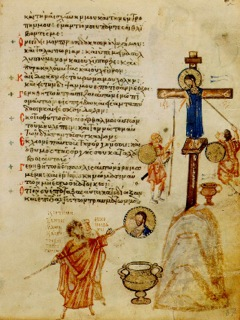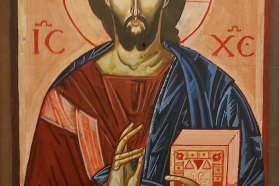Sunday Reflection with Fr Robin Gibbons - 5 July 2020

Iconoclasm, Chludov
14th Sunday in Ordinary Time
In the recent discussions about Black Lives Matter and the removal of imagery that glorifies oppression and slavery, attention was turned to the prevalence of Europeanized imagery of Christ and his mother, in which they are portrayed in a totally Caucasian manner, white skin, blondish hair, blue eyes, and the demand is that these too be removed as symbols of dominance. One shouldn't make light of such demands, they always have a serious component, but as an artist, involved with religious art, this kind of sentimentalized imagery that many people seem to love, really does need to be replaced, if only to move us on in the engagement of art and worship.
The question for me has always been, what is the purpose of Christian art? In its development we can see how Christians used the art and symbols available to them, taking over certain images and changing the symbolic meaning to link it with the Gospel tradition. The very first use of art was either in the catacomb places, mainly in the context of remembering the dead and the Christian hope of Christ who is risen, or in the setting of the baptisteries where the faith taught was seen in the imagery surrounding the catechumens about to be baptized. So many of these images survive showing us, not this sentimental almost effete portrait of Jesus, but a robust, vigorous, Christ who, by a common consent, changes from the Roman hero god, to an agreed convention of an Eastern bearded figure, one we can recognize throughout history. But he isn't European, and in its wisdom the community of the Church never laid down any regulations about how he ought to be imaged, the risen Lord belongs to all peoples and nations.
There was, and is, always a tension implicit in our faith, between imaging people and events that tell the story of faith and the second Commandment's prohibition of portraying God in any form. This commandment about graven images rears its head frequently, it has been responsible for much destruction of religious art during the centuries, but in the first millennium during two great periods of religious iconoclasm, between 726 and 787and 814 to 842, saints like John of Damascus produced a coherent theology of why and how we can image Christ and the saints, making a huge distinction between worship given only to God and veneration, honour given to other things. For John the Incarnation and Theosis of Christ is all important in this: 'I honour all matter, and venerate it. Through it, filled, as it were, with a divine power and grace, my salvation has come to me'. (On the Defence of Icons)
But in all this nobody denied the ultimate icons of Christ, the Eucharist and the Community who form his body, it remains true that the art of the liturgy is about pointing beyond itself, to the Divine world which we cannot see, t is a servant, not a master.
So why have I chosen this theme? Have a quick look at the readings, they all point to images and symbols, Zecheriah showing us the saviour King riding on a colt, not in glory, but in humility, turning upside down all our concepts of might and power. Psalm 145 tells us to glorify and praise God through the creation, 'let all your works give thanks'(v 10) giving us permission as it were to venerate and love God in his works, the letter to the Romans drills into us the theology of Christian Initiation, that we are filled the Spirit and live by the Spirit, the one who gives life to mortal bodies, now Temples of the Spirit. Lastly the Gospel has Jesus teaching us that knowledge is nothing to do with being intellectually clever but having the eyes of faith, to turn our lives upside down in the Gospel way, becoming the little ones in order that we might know God. It's a challenge to us, as Covid 19 has changed much, so the debates on oppression, slavery and any form of prejudice man that we as Christians must root out any image of Christ that does not lead to knowing him, it also means we need to take on board the Second Vatican Council's teaching on art for the Church, particularly in the liturgy, that we recover a 'noble simplicity' becoming again those little ones, simple and open to becoming true icons of Christ!
Lectio
Greogory of Nyssa, two thoughts:
"Concepts create idols; only wonder comprehends anything. People kill one another over idols. Wonder makes us fall to our knees."
"Christ is the artist, tenderly wiping away all the grime of sin that disfigures the human face and restoring God's image to its full beauty."
From John of Damascus
Defence Against Those Who Oppose the Veneration of Images
I do not worship matter, I worship the God of matter, who became matter for my sake, and deigned to inhabit matter, who worked out my salvation through matter. I will not cease from honouring that matter which works my salvation. I venerate it, though not as God. How could God be born out of lifeless things? And if God's body is God by its union with him, it is changeless. The nature of God remains the same as before, the flesh created in time is brought to life by a logical and reasoning soul.
I honour all matter, and venerate it. Through it, filled, as it were, with a divine power and grace, my salvation has come to me. Was the three-times happy and blessed wood of the Cross not matter? Was the sacred and holy mountain of Calvary not matter? What of the life-giving rock, the Holy Tomb, the source of our resurrection - was it not matter? Is the holy book of the Gospels not matter? Is the blessed table which gives us the Bread of Life not matter? Are the gold and silver, out of which crosses and altar-plate and chalices are made not matter? And before all these things, is not the body and blood of our Lord matter? Either stop venerating all these things, or submit to the tradition of the Church in the venerating of images, honoring God and his friends, and following in this the grace of the Holy Spirit. Do not despise matter, for it is not despicable. Nothing that God has made is. Only that which does not come from God is despicable - our own invention, the spontaneous decision to disregard the law of human nature, i.e., sin.
Fr Robin is an Eastern Rite Catholic Chaplain for Melkites in the UK. He is also an Ecumenical Canon of Christ Church Cathedral, Oxford. You can follow him on Twitter: @RobinGibbon


















